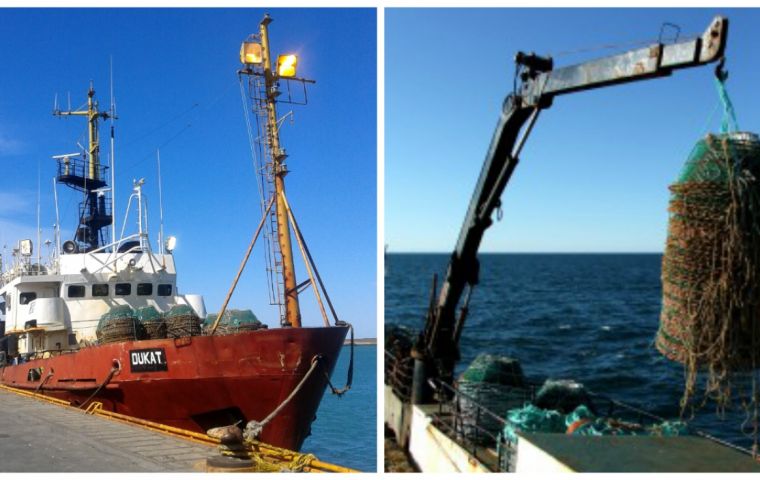MercoPress. South Atlantic News Agency
Argentina undertakes third scientific evaluation survey of Southern king crab
 The task in undertaken simultaneously with five vessels, Dukat, Talisman, Atlantic Express, Tango I and Tango II, with two INIDEP observers on each of them
The task in undertaken simultaneously with five vessels, Dukat, Talisman, Atlantic Express, Tango I and Tango II, with two INIDEP observers on each of them Argentina's National Institute for Fisheries Research and Development, INIDEP, has started a scientific survey aimed at assessing the Southern king crab (Lithodes santolla) in its central Patagonian distribution area. This is the third consecutive year in which the survey is carried out and includes the San Jorge Gulf and platform waters, between 43° 30 'and 48° South latitude, in jurisdictions of the Nation, and Chubut and Santa Cruz provinces.
The task in undertaken simultaneously with five commercial king crab vessels (Dukat, Talisman, Atlantic Express, Tango I and Tango II) and on each of them are two scientist observers from INIDEP, with the support of the crew and companies that catch the resource.
The main objective of this study is to estimate the relative abundance indexes, describe the 2019 spatial distribution, mainly of commercial concentrations and of different biological aspects of the stock.
The programmed activities include: counting of crabs in the case of females, collection of necrosis data, loss of appendices, morph metric relationships and tissue sampling for genetic cheat studies, length and weight measurements, determination of reproductive stage, percentage of egg, and determine their egg quality.
All the accompanying fauna, usually composed of other crabs, stars, bristle-stars and sea urchins, will also be recorded and quantified. Additionally there will be assessment of discards, mainly the spider crab (Libidoclaea granaria).
Furthermore some 1,500 females greater than 70 mm shell length and 1,500 males over 90 mm will be tagged. Among the main expected results of this activity are obtaining data on the direction and distance of movements of the crabs and make comparisons with the results previously obtained.
The determination of the spatial distribution, sex ratio, size structure, reproductive condition and relative abundance of king crab is fundamental to evaluate the general state of the stock subjected to exploitation.
With the collected information, a relative reference index will be generated based on the crab abundance that will allow biomass estimates and suggest catch quotas in each jurisdiction for the 2019-20 season. (FIS).




Top Comments
Disclaimer & comment rulesCommenting for this story is now closed.
If you have a Facebook account, become a fan and comment on our Facebook Page!